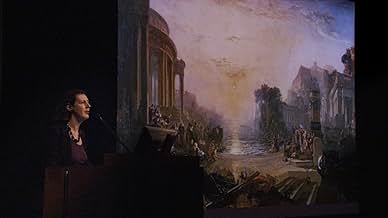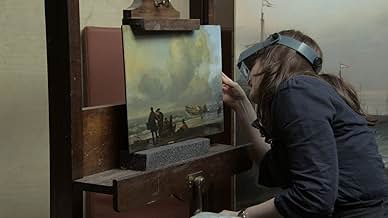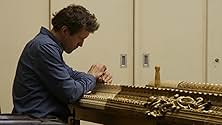CALIFICACIÓN DE IMDb
7.3/10
1.7 k
TU CALIFICACIÓN
Agrega una trama en tu idiomaA documentary that goes inside one of the great museums of the world: The National Gallery in London.A documentary that goes inside one of the great museums of the world: The National Gallery in London.A documentary that goes inside one of the great museums of the world: The National Gallery in London.
- Dirección
- Guionista
- Elenco
- Premios
- 1 premio ganado y 9 nominaciones en total
Nicholas Penny
- Self - director of the National Gallery
- (sin créditos)
Luke Syson
- Self - curator, National Gallery
- (sin créditos)
- Dirección
- Guionista
- Todo el elenco y el equipo
- Producción, taquilla y más en IMDbPro
Opiniones destacadas
Frederick Wiseman's new documentary NATIONAL GALLERY runs three hours; three hours of dissecting and analyzing the workings of one of the world's great Museums - the National Gallery in London England. Probing paintings' meaning and content; structure and design; the decisions involved in the way venerated and treasured works of art are conserved, restored, cleaned, lit and hung. We also are privy to the voices of the docents, curators, and staff talking about specific artworks connecting their audiences to the aesthetics, beauty, history, and science of conservation; the various pathways a painting takes from its original creation; its entry into various collections, and finally to its safe-keeping for posterity in the National Gallery Museum. We even listen to Nicholas Penny, the rumpled-haired Museum Director in a lecture taking a stab at Poussin - admitting that he is not sure if he likes the work, but is always intrigued by it.
Questions of elitism and exclusivity vs.accessibility and egalitarianism in light of budgetary considerations are discussed at meetings; there are lots of meetings. The film might have edited out some of the discussions - but I felt that the prosaic, the boring, the everyday-ness was worth observing. The running of a museum is not always glamorous. The decisions that establishments have to make in order to grip the public's interest - what lengths do they go to attract visitors, and at what price to their institution?
Wiseman just lets his camera roll; he never uses "voice overs". His working method and vitality at age 84 is unchanged - not intrusive - the filmmaker is always invisible - interviews are conducted by others. Frederick Wiseman lets us be the proverbial "fly on the wall" in a space that ordinarily would be bug-proof.
I loved watching one of the restorers discussing the cleaning of Velasquez' Christ in The House of Martha and Mary and passionately ponder the dilemma - do we over-strip the varnish used 100's of years ago and thereby brighten and change the artists' original intent? Ethical problems and compromises come into question. An in-house construction of a triptychs' impressive frame delicately carved by the crafts-men and women associated with the Museum, and the lighting of the finished piece held me spellbound, as did the issue of a cast shadow obscuring the top 1/4 of the painting once the work was installed. We also pay heed to restorers scraping away tiny slivers of paint with scalpels, Q-tips, eye-droppers, etc. and then put the minuscule paint shavings on a slide tray to be placed under a microscope to be scrutinized - to be thoroughly examined yielding a plethora of information; new scientific techniques today make this kind of investigation possible. We mark the fragility of time's passing on art realizing that there are effects that you have to live with, and guard against, but ultimately methodical and deductive technical intervention will be called upon to "save" the work from aging and deterioration.
The camera also takes us outside the Museum with aerial views of Trafalgar Square lit by the grays of daylight to the shimmering of the early darkness -focusing on the diverse community waiting patiently in the cold to to see the Da Vinci exhibition "Painter at the Court of Milan" (2012.) We are never far away from the human response to art - the intensity of the onlooker's gaze, the curiosity, confusion, delight, horror and interior peace that art can inculcate.
Other blockbusters such as "Turner Inspired by the light of Claude" and "Metamorphosis: Titian 2012" are exhibitions that we are fortunate to attend and hear curators/docents of varying sizes, ages and accents advocating for art's fascination and magnetism; confronting us with their disparate styles - some humorous, others psychoanalytical - all informative. Each artwork has a presence with an individual history and personal narrative imprinted on its essence - like life itself this movie is thrilling, enigmatic, complex and a singular jewel.
Questions of elitism and exclusivity vs.accessibility and egalitarianism in light of budgetary considerations are discussed at meetings; there are lots of meetings. The film might have edited out some of the discussions - but I felt that the prosaic, the boring, the everyday-ness was worth observing. The running of a museum is not always glamorous. The decisions that establishments have to make in order to grip the public's interest - what lengths do they go to attract visitors, and at what price to their institution?
Wiseman just lets his camera roll; he never uses "voice overs". His working method and vitality at age 84 is unchanged - not intrusive - the filmmaker is always invisible - interviews are conducted by others. Frederick Wiseman lets us be the proverbial "fly on the wall" in a space that ordinarily would be bug-proof.
I loved watching one of the restorers discussing the cleaning of Velasquez' Christ in The House of Martha and Mary and passionately ponder the dilemma - do we over-strip the varnish used 100's of years ago and thereby brighten and change the artists' original intent? Ethical problems and compromises come into question. An in-house construction of a triptychs' impressive frame delicately carved by the crafts-men and women associated with the Museum, and the lighting of the finished piece held me spellbound, as did the issue of a cast shadow obscuring the top 1/4 of the painting once the work was installed. We also pay heed to restorers scraping away tiny slivers of paint with scalpels, Q-tips, eye-droppers, etc. and then put the minuscule paint shavings on a slide tray to be placed under a microscope to be scrutinized - to be thoroughly examined yielding a plethora of information; new scientific techniques today make this kind of investigation possible. We mark the fragility of time's passing on art realizing that there are effects that you have to live with, and guard against, but ultimately methodical and deductive technical intervention will be called upon to "save" the work from aging and deterioration.
The camera also takes us outside the Museum with aerial views of Trafalgar Square lit by the grays of daylight to the shimmering of the early darkness -focusing on the diverse community waiting patiently in the cold to to see the Da Vinci exhibition "Painter at the Court of Milan" (2012.) We are never far away from the human response to art - the intensity of the onlooker's gaze, the curiosity, confusion, delight, horror and interior peace that art can inculcate.
Other blockbusters such as "Turner Inspired by the light of Claude" and "Metamorphosis: Titian 2012" are exhibitions that we are fortunate to attend and hear curators/docents of varying sizes, ages and accents advocating for art's fascination and magnetism; confronting us with their disparate styles - some humorous, others psychoanalytical - all informative. Each artwork has a presence with an individual history and personal narrative imprinted on its essence - like life itself this movie is thrilling, enigmatic, complex and a singular jewel.
A wonderful documentary of the National Gallery, a great museum in London and one of the greatest in the world with a large collection of masterpieces dated back from 16th century. This documentary makes it a living museum through the exhibition of several paintings, the galleries and the public around them. There are several explanatary commentaries by the museum technicians about the paintings and some talks also about the museum direction and planning all with excellent quality and remarkable detail. Indeed one of the best movies of 2014.
For those who enjoy the experience of visiting art museums, National Gallery' is a must-see. The brilliant objectivist documentarian Frederick Wiseman captures the iconic British museum from every side imaginable. Over the course of three hours, he offers a grand glimpse of the museum's collection and temporary exhibits as others look or discuss them, from art historians to tour guides. Fixed history and interpretation are celebrated in both Wiseman's camera and the loosely strung scenes of people in the exhibition halls. The movie cuts to various perspectives of the museum, from details of paintings to entire galleries, as people gaze at works. But Wiseman also captures the people operating the museums during PR and budget meetings and, most intriguingly, at work restoring paintings. No one looks at the camera to explain their work and Wiseman never even uses superimposed title cards, yet you will come away enlightened.
As observational documentaries go, Frederick Wiseman's "National Gallery" is pretty close to sublime. In typical Wiseman style there's no voice-over and no score; he simply places his cameras and his microphones inside the buildings and lets us see the paintings and hear the words spoken by the staff, at meetings or in discussing the art with the public. It lasts for three hours and if you love great art you just might have an orgasm watching the flow of masterpieces lovingly framed and spoken about. However, if art isn't quite your bag this might be the most boring film ever made.
At least Wiseman doesn't do it all in one continuous take, the way Sokurov did with "Russian Ark" whose roving camera induced in me a feeling of seasickness. Wiseman plumps for detail and how. The art is, of course, extraordinary but so too are the faces of the punters who come to stare. The screen itself becomes a canvas in which Wiseman's camera paints the faces of these onlookers and it is beautiful to behold. What's less beautiful are the commentaries of the gallery's guides as they try to 'explain' the paintings to the various tour guides. Love it or loathe it, it isn't like any other film about 'art' that you are likely to see which is some sort of achievement in itself.
At least Wiseman doesn't do it all in one continuous take, the way Sokurov did with "Russian Ark" whose roving camera induced in me a feeling of seasickness. Wiseman plumps for detail and how. The art is, of course, extraordinary but so too are the faces of the punters who come to stare. The screen itself becomes a canvas in which Wiseman's camera paints the faces of these onlookers and it is beautiful to behold. What's less beautiful are the commentaries of the gallery's guides as they try to 'explain' the paintings to the various tour guides. Love it or loathe it, it isn't like any other film about 'art' that you are likely to see which is some sort of achievement in itself.
"National Gallery" (2014, Frederick Wiseman), a documentary about the renowned British art museum, makes a strong case for major arts institutions. With a three-hour running time, we finish with a firm idea of both the inestimable value and fragility of The National Gallery. With a haphazard, seemingly random structure, the documentary shows people regardless of their actual involvement with the museum. We see patrons silently absorbing art; board members discussing their goals; curators discussing philosophy and techniques; janitors; wall painters; a board meeting where the discussion is about an unwelcome public marathon; budget cuts discussed at another board meeting; various educators, various video crews, museum guides analyzing master works; a male and a female nude model separately posing for what appears to be an advanced art class; adventurous Arctic activists bravely hoisting a banner at the museum's entrance; a pianist performing amid priceless paintings and a reasonably erotic, heterosexual ballet dance. Wiseman makes a compelling statement about the worth of visual arts, and it couldn't arrive to this brutal world at a better time.
Curiously, Wiseman does not introduce museum employees with captions or inform the viewer what event is occurring. This helps makes his statement universal. Rather than just a story of the National Gallery, the viewer is encouraged to gain appreciation for his or her local cultural institutions.
There are some memorable segments. I really enjoy the brief excerpts of lectures where experts interpret details in master works. The discussion of Paul Reubens's "Samson and Delilah (1609- 1610)" is interesting. So is the curator's lecture describing a Rembrandt portrait with a hidden second composition of the same subject. One of the senior museum big shots tells a laugh-out-loud joke about Moses and the Ten Commandments. Another museum guide informs a group of adolescents, several of whom are Black, that the Gallery owes its early funding to the Slave Trade. Leonardo da Vinci's power is also expressed or suggested multiple times. Finally, the ballet dance that is staged in the vicinity of two large master works reminds us that visual arts tickle the public's imagination in many ways.
It is an uneven journey, but it finishes with rising interest. "The National Gallery" will likely be enjoyed by artists of many disciplines who wish to be reminded of culture's power. It sure would be nice if the arts flourished in this particularly barbaric period while the world's militaries languished.
Curiously, Wiseman does not introduce museum employees with captions or inform the viewer what event is occurring. This helps makes his statement universal. Rather than just a story of the National Gallery, the viewer is encouraged to gain appreciation for his or her local cultural institutions.
There are some memorable segments. I really enjoy the brief excerpts of lectures where experts interpret details in master works. The discussion of Paul Reubens's "Samson and Delilah (1609- 1610)" is interesting. So is the curator's lecture describing a Rembrandt portrait with a hidden second composition of the same subject. One of the senior museum big shots tells a laugh-out-loud joke about Moses and the Ten Commandments. Another museum guide informs a group of adolescents, several of whom are Black, that the Gallery owes its early funding to the Slave Trade. Leonardo da Vinci's power is also expressed or suggested multiple times. Finally, the ballet dance that is staged in the vicinity of two large master works reminds us that visual arts tickle the public's imagination in many ways.
It is an uneven journey, but it finishes with rising interest. "The National Gallery" will likely be enjoyed by artists of many disciplines who wish to be reminded of culture's power. It sure would be nice if the arts flourished in this particularly barbaric period while the world's militaries languished.
¿Sabías que…?
- ConexionesReferenced in Film Junk Podcast: Episode 493: Predestination (2014)
- Bandas sonorasSonate pour piano Op. 31 no 3
Music by Ludwig van Beethoven
Performed by Kausikan Rajeshkumar, RCM
dans la cadre de Belle Shenkamn Music Program (correct is "Belle Shenkman music programme")
[Récital]
Selecciones populares
Inicia sesión para calificar y agrega a la lista de videos para obtener recomendaciones personalizadas
- How long is National Gallery?Con tecnología de Alexa
Detalles
- Fecha de lanzamiento
- Países de origen
- Sitio oficial
- Idioma
- También se conoce como
- 歡迎光臨國家畫廊
- Locaciones de filmación
- Productoras
- Ver más créditos de la compañía en IMDbPro
Taquilla
- Total en EE. UU. y Canadá
- USD 253,941
- Fin de semana de estreno en EE. UU. y Canadá
- USD 10,049
- 9 nov 2014
- Total a nivel mundial
- USD 354,971
- Tiempo de ejecución3 horas
- Color
- Relación de aspecto
- 1.85 : 1
Contribuir a esta página
Sugiere una edición o agrega el contenido que falta

Principales brechas de datos
By what name was National Gallery (2014) officially released in Canada in English?
Responda






















